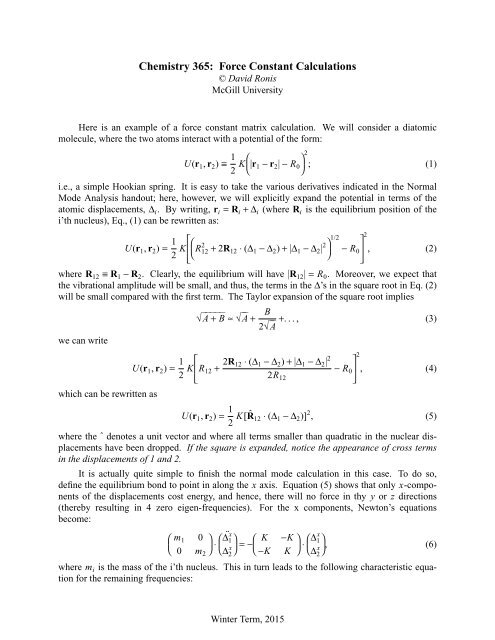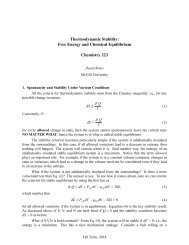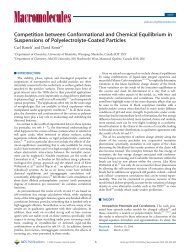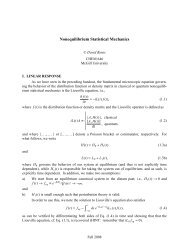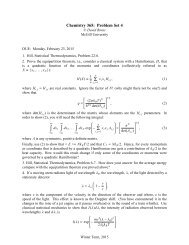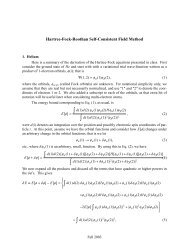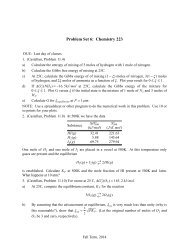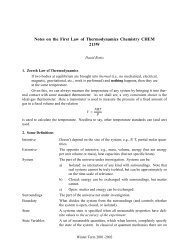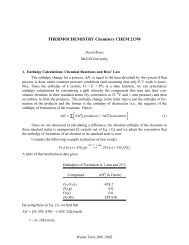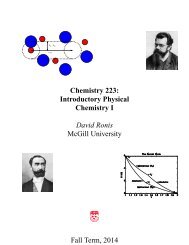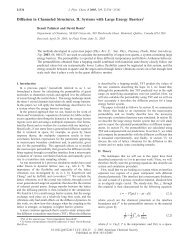Force Constant Matrix Calculations
Force Constant Matrix Calculations
Force Constant Matrix Calculations
You also want an ePaper? Increase the reach of your titles
YUMPU automatically turns print PDFs into web optimized ePapers that Google loves.
Chemistry 365: <strong>Force</strong> <strong>Constant</strong> <strong>Calculations</strong>©David RonisMcGill UniversityHere is an example of a force constant matrix calculation. We will consider a diatomicmolecule, where the two atoms interact with a potential of the form:U(r 1 , r 2 ) ≡ 1 22 K⎛ ⎝ |r ⎞1 − r 2 | − R 0 ; (1)⎠i.e., a simple Hookian spring. It is easy to take the various derivatives indicated in the NormalMode Analysis handout; here, however, we will explicitly expand the potential in terms of theatomic displacements, ∆ i . Bywriting, r i = R i +∆ i (where R i is the equilibrium position of thei’th nucleus), Eq., (1) can be rewritten as:U(r 1 , r 2 ) = 1 1/222 K⎡ ⎛⎢⎝ R2 12 + 2R 12 ⋅ (∆ 1 −∆ 2 ) + |∆ 1 −∆ 2 | 2 ⎞ ⎤− R⎠ 0⎥⎦ , (2)⎣where R 12 ≡ R 1 − R 2 . Clearly, the equilibrium will have |R 12 | = R 0 . Moreover, we expect thatthe vibrational amplitude will be small, and thus, the terms in the ∆’s inthe square root in Eq. (2)will be small compared with the first term. The Taylor expansion of the square root implieswe can writewhich can be rewritten as√⎺ ⎺⎺⎺⎺ A + B ≈ √⎺⎺A +B +..., (3)2√⎺⎺AU(r 1 , r 2 ) = 1 2 K⎡ ⎢⎣R 12 + 2R 12 ⋅ (∆ 1 −∆ 2 ) + |∆ 1 −∆ 2 | 22R 12− R 0⎤⎥⎦2, (4)U(r 1 , r 2 ) = 1 2 K[ ˆR 12 ⋅ (∆ 1 −∆ 2 )] 2 , (5)where the ˆ denotes a unit vector and where all terms smaller than quadratic in the nuclear displacementshave been dropped. If the square isexpanded, notice the appearance of cross termsin the displacements of 1 and 2.It is actually quite simple to finish the normal mode calculation in this case. To do so,define the equilibrium bond to point in along the x axis. Equation (5) shows that only x-componentsof the displacements cost energy, and hence, there will no force in thy y or z directions(thereby resulting in 4 zero eigen-frequencies). For the x components, Newton’s equationsbecome:⎛ m 1⎝ 00m 2⎞⎠ ⋅⎛∆ ¨1x ⎞⎝ ⎠ =−⎛ K⎝ −K∆ x 2−KK⎞⎠ ⋅ ⎛ ⎝∆1x∆2x⎞⎠ , (6)where m i is the mass of the i’th nucleus. This in turn leads to the following characteristic equationfor the remaining frequencies:Winter Term, 2015
Chemistry 365 -2- <strong>Force</strong> <strong>Constant</strong> <strong>Calculations</strong>0 = det ⎡ ⎛ m 1⎢⎝ ⎣00 ⎞m 2 ⎠ ω 2 − ⎛ ⎝K−K−KK⎞⎤⎠⎥⎦= (m 1 ω 2 − K)(m 2 ω 2 − K) − K 2and= ω 2 (µω 2 − K),where µ ≡ m 1 m 2 /(m 1 + m 2 )isthe reduced mass. Thus we pick up another zero frequency and anonzero one with ω = √⎺ ⎺⎺ K/µ, which is the usual result. (Note that we don’t count ± rootstwice--WHY?).Winter Term, 2015


